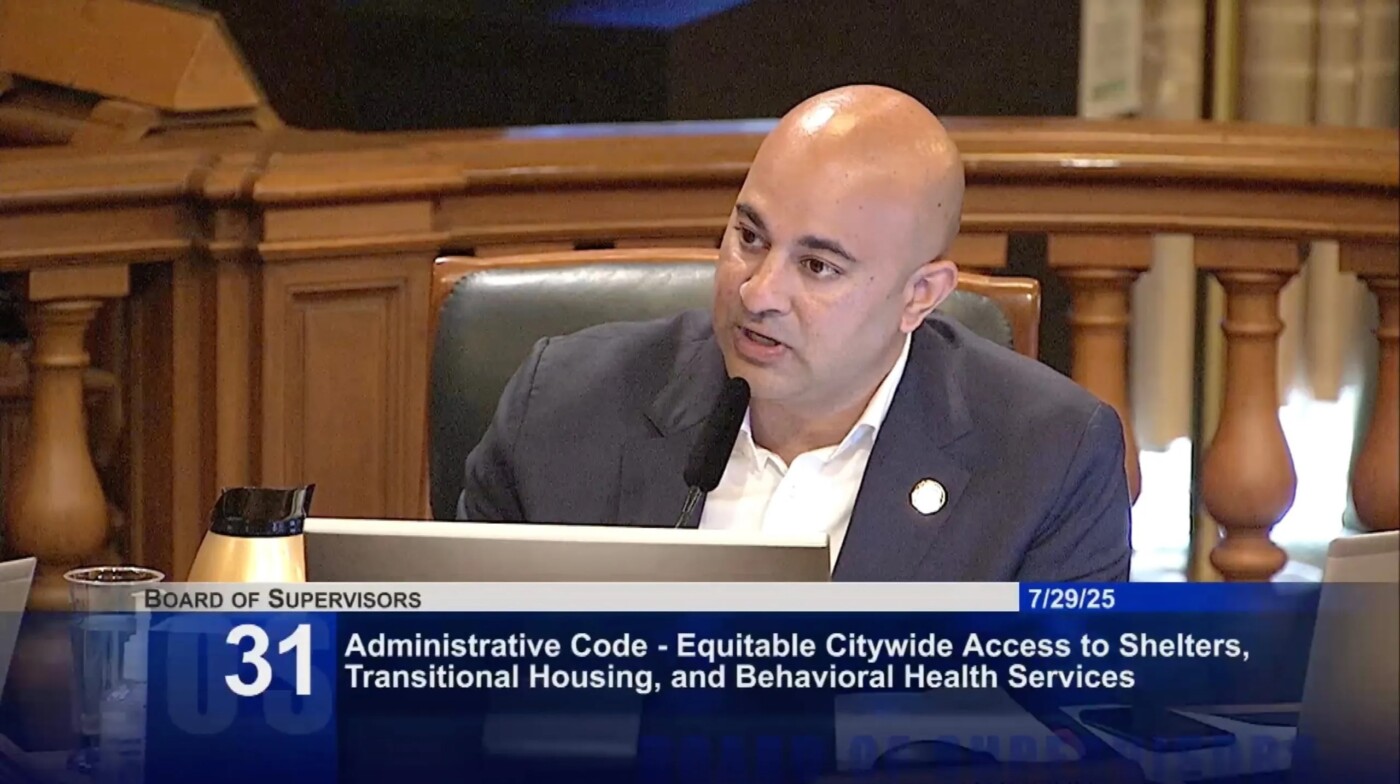THE CITY AND COUNTY OF SAN FRANCISCO this week moved closer to implementing a policy for new shelters, transitional beds and behavioral health facilities to be matched to a neighborhood’s needs, rather than clustered in certain parts of the city.
The ordinance, authored by Supervisor Bilal Mahmood, who represents District 5, will temporarily prohibit new city-funded shelters or treatment centers from being built in neighborhoods that already have more open shelter and transitional beds than the number of homeless people in the neighborhood.
It will also ban new shelters and behavioral health facilities from being built within 300 feet of each other.
Either restriction could be overcome with a waiver from the Board of Supervisors. The prohibition does not apply to privately funded facilities and includes other exceptions, including for families receiving state or city housing support, and for facilities proposed in neighborhoods that have lost shelter space within the last year.
The amendment to the city’s administrative code, titled the One City Shelter Act, is the first restriction on shelters in neighborhoods that are zoned for them. It had four other co-sponsors and passed 9-2, with Supervisors Connie Chan and Chyanne Chen as the holdouts.
The local law is meant to stop the oversaturation of certain neighborhoods with shelters and related care facilities — namely the Tenderloin, SoMa and Lower Nob Hill. It will require a second vote in September before becoming law and will be effective on January 1 if given final approval. The restrictions sunset at the end of 2031.
Imbalance across neighborhoods
The city defines 41 neighborhoods for planning purposes. Mahmood said during his presentation on the ordinance ahead of the vote that there were more than 1,000 homeless people in the city spread out across 30 neighborhoods that didn’t have access to nearby shelters or care. Meanwhile, 75% of shelter and transitional beds were clustered in just eight other neighborhoods.
“That kind of imbalance sends a message, whether intentional or not, that only a few neighborhoods are expected to shoulder the city’s response to a citywide crisis,” he told his colleagues. “It creates a dynamic where neighborhoods like the Tenderloin and SoMa are carrying the weight while others are left on the sidelines,” Mahmood said.
He said the policy was “not about shifting burdens. It’s about finally building a balanced system that serves all San Franciscans. In the Tenderloin we have 3,500 children and not a single toy store,” he said.
He later said that the Tenderloin was central to the city’s efforts to revive the city and its downtown.
“You cannot have a downtown revitalization without a Tenderloin revitalization,” he said.
Chan said she favored a moratorium on new shelters in neighborhoods that had too many, but opposed the other language in the ordinance, which she said was “overly prescriptive.”
Chen said she wanted more permanent solutions like transitional housing.
But other supervisors said the ordinance was a good first step in changing the way the city allocated care resources that was a needed departure from business as usual.
Supervisor Myrna Melgar, who represents District 7, said before the vote that the ordinance included flexibility to meet the different needs of different districts, rather than previous attempts to require each district to have suite of services housed in a “navigation center.”
Melgar said her district, which includes the Inner Sunset area, had seen an uptick in need after the city began increased police enforcement in the SoMa and Tenderloin neighborhoods in recent months. She said that left many people far from the care and services they needed.
“That kind of imbalance sends a message, whether intentional or not, that only a few neighborhoods are expected to shoulder the city’s response to a citywide crisis.”
San Francisco District 5 Supervisor Bilal Mahmood
“I’m glad that we’re even having this conversation,” she told colleagues. “Because prior to this, it wasn’t even an acknowledgement that, you know, there is a lack of equity both in communities that have taken more than their fair share, but an acknowledgement that some communities have no support and have a really big problem, like mine,” she said.
The ordinance gained the backing of several community development and nonprofit groups, including the Tenderloin Community Benefit District, a nonprofit neighborhood improvement organization.
The organization’s executive director, Kate Robinson, said in a statement that the Tenderloin had carried a disproportionate share of the city’s shelter beds, transitional housing and behavioral health facilities.
“While our neighborhood has always embraced a spirit of compassion, the decades-long pattern of overconcentration–paired with an absence of citywide planning — has deeply strained our local infrastructure, hindered economic development, and challenged the overall well-being of both housed and unhoused residents,” Robinson said.
The post SF advances ‘One City Shelter Act’ ordinance appeared first on Local News Matters.
